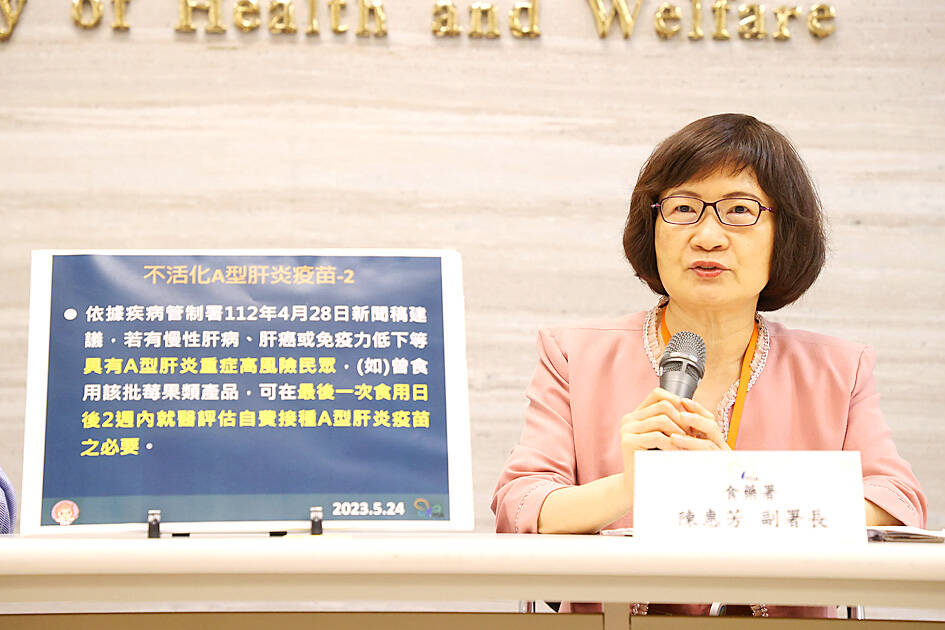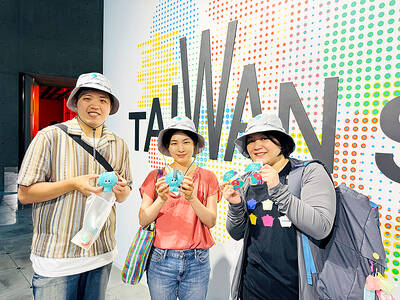While liquid bandage products are handy, some precautions should be taken, and people with a glucose-6-phosphate dehydrogenase (G6PD) deficiency should avoid them, as they contain an ingredient that might trigger hemolytic anemia in people with the condition, the Food and Drug Administration (FDA) said yesterday.
Liquid bandages create a waterproof clear shield over a wound, protecting it from germs and dirt to help prevent skin infection.
As they are classified as a medical device in Taiwan, manufacturers or importers of liquid bandages require a permit obtained from the Ministry of Health and Welfare, and only those with a medical device dealer’s permit can sell the products, FDA Deputy Director Cheng Hwei-fang (陳惠芳) said.

Photo: CNA
Liquid bandages are a sterile liquid, semi-liquid, or powder and liquid combination used to cover a skin wound, FDA Medical Device and Cosmetics Division section chief Lin Hsiu-te (林修德) said.
They mainly come in two forms — brush-on and spray — and have the advantage of covering areas that are difficult to cover with traditional plastic or fabric plasters, such as the knuckles or between the fingers, he said.
However, liquid bandages should not be used on larger wounds, scrapes, ulcers, festering wounds or burns, Lin said, adding that people should also avoid applying them near their eyes or nose, or on the mucosa or sensitive skin.
Moreover, as liquid bandages mostly contain pyroxyline, benzyl alcohol and camphor, people with a G6PD deficiency should avoid using them, he said.
Exposure to camphor might trigger acute hemolytic anemia — a blood disorder in which red blood cells are destroyed faster than they can be made — in people with a G6PD deficiency, he said.
People should follow the three safety steps for using medical devices: “recognizing” the products as a medical device, “checking” if the outer package of the product has an approval number from the health ministry and “reading” the instruction leaflet for proper use of the device, Chen said.

The Executive Yuan yesterday approved a southwestern extension of the Sanying MRT Line from New Taipei to Bade District (八德) in Taoyuan, with a goal of starting construction by late 2026. The 4.03-kilometer extension, featuring three new stations, will run from the current terminus at Yingtao Fude Station (LB12) in New Taipei City to Dannan Station (LB14), where it will connect with Taoyuan’s Green Line, New Taipei City Metro Corp said in a statement. This extension will follow the completion of core Sanying Line, a 14.29-kilometer medium-capacity system linking Tucheng (土城), Sansia (三峽)

CARGO LOSS: About 50 containers at the stern of the ‘Ever Lunar’ cargo ship went overboard, prompting the temporary closure of the port and disrupting operations Evergreen Marine Corp, Taiwan’s largest container shipper, yesterday said that all crew members aboard the Ever Lunar (長月) were safe after dozens of containers fell overboard off the coast of Peru the previous day. The incident occurred at 9:40am on Friday as the Ever Lunar was anchored and waiting to enter the Port of Callao when it suddenly experienced severe rolling, Evergreen said in a statement. The rolling, which caused the containers to fall, might have been caused by factors including a tsunami triggered by an earthquake in Russia, poor winter sea conditions in South America or a sudden influx of waves,

The Ministry of Culture yesterday officially launched the “We TAIWAN” cultural program on Osaka’s Nakanoshima sandbank, with the program’s mascot receiving overwhelming popularity. The cultural program, which runs from Aug. 2 to 20, was designed to partner with and capitalize on the 2025 World Expo that is being held in Osaka, Japan, from April 13 to Oct. 13, the ministry said. On the first day of the cultural program, its mascot, a green creature named “a-We,” proved to be extremely popular, as its merch was immediately in high demand. Long lines formed yesterday for the opening

The Taipei Summer Festival is to begin tomorrow at Dadaocheng Wharf (大稻埕), featuring four themed firework shows and five live music performances throughout the month, the Taipei Department of Information and Tourism said today. The festival in the city’s Datong District (大同) is to run until Aug. 30, holding firework displays on Wednesdays and the final Saturday of the event. The first show is scheduled for tomorrow, followed by Aug. 13, 20 and 30. To celebrate the 30th anniversary of Disney Pixar's movie Toy Story, the festival has partnered with Walt Disney Co (Taiwan) to host a special themed area on